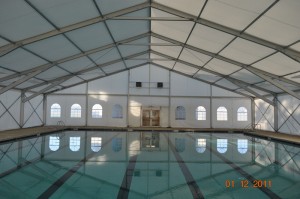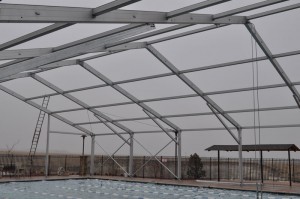[row]
[column md=”10″ offset_md=”1″]

Architectural membrane structures offer a reliable solution for maintaining athletic training at the same facility year-round. Once complete, your outdoor pool will function as an indoor pool, at a fraction of the cost of new construction.
Let’s discuss the different types of Architectural Membrane Structures and how to approach utilizing the right one for you. There are three basic classifications for structures and choosing the right one for your facility is very important. Things to consider are as follows;
- What activities are we wanting to do inside the structure?
- How long will we want the structure erected? Seasonally or Long Term?
- What amenities are we looking for in our facility that the structure will provide?
- Who owns the facility you desire to cover? City/County? HOA? Private Entity? You?
- Is the facility already existing or are you building a new Aquatic Facility?
By answering the above questions, you will begin to determine what you need to function in your current facility. Below are additional explanations of structure classifications.
- TEMPORARY STRUCTURE: by definition, this is a structure that would remain erected for less than 180 days consecutively. When considering a temporary structure, remember that there are residual operating costs’ that have to be part of the consideration. Each season there is a cost associated with the erection and dismantling of the fabric structure.
- SEMI-PERMANANT STRUCTURE: by definition, this is a structure that would remain up for more than 180 days, but not more than 1 calendar year consecutively. When considering a semi-permanent structure, local Code requirements and how the City or County classifies the structure will determine the next steps in being Code Compliant. This varies across the Country.
- PERMANENT STRUCTURES: by definition, this is a structure that will remain installed and functioning indefinitely. When considering a permanent structure, the local City or County will dictate the requirements of Code Compliance. This may include meeting Energy Codes (i.e.; insulated buildings). All additional costs required for permanent classification must be considered. This classification is a longer process and involves working closely with Local Building Officials and Planning Committees.
[/column]
[/row]
[row]
[column md=”6″ offset_md=”1″]
The unique benefits of Architectural Membrane Structures are that as your needs change and grow, the structure has the ability to be modified to grow with you. Initial consideration is the budget and R.O.I. making sense. If you envision someday having a permanent facility but cannot budget the additional expense currently, designing the structure to accommodate the necessary additions such as insulation, HVAC (dehumidification), brick and glass walls …. Etc. is the way to ensure that when you are ready to expand, the building is ready! Then as your budget allows for additions, you are not burdened with re-purchasing a new building.
[/column]
[column md=”4″]

[/column]
[/row]
